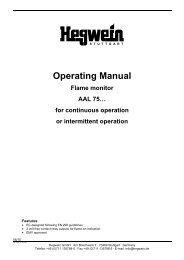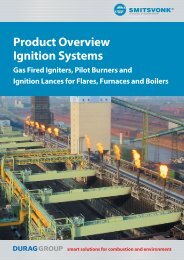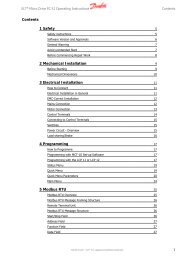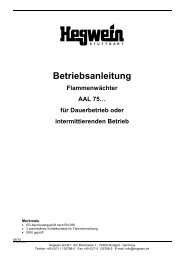You also want an ePaper? Increase the reach of your titles
YUMPU automatically turns print PDFs into web optimized ePapers that Google loves.
Page 12 D-<strong>LX</strong> <strong>700</strong><br />
10. Technical Data<br />
• Permissible ambi<strong>en</strong>t temperatures: -20°C…+60°C (0°F…+140°F,<br />
(other temperatures upon request)<br />
• Safety time:.....................................1 s (other times available upon request)<br />
• Permissible operating modes:........intermitt<strong>en</strong>t and continuous operation; 72-hour operation in<br />
systems operating according to TRD 604<br />
• Enclosure rating (EN 60529):.........IP67<br />
• Electrical connection: ...................1.5m (5 ft.) cable (8 conductor, 1 mm² / 18 gauge),<br />
T = -60 to +180°C (-80°F to 360°F)<br />
• Weight: ...........................................approx. 1.8 kg (4 lb.)<br />
10.1. Technical Data of the Compact Flame Scanner<br />
• Spectral s<strong>en</strong>sitivity..........................190 nm - 520 nm D-<strong>LX</strong> <strong>700</strong> UA<br />
280 nm - 410 nm D-<strong>LX</strong> <strong>700</strong> UAF<br />
300 nm - 1100 nm D-<strong>LX</strong> <strong>700</strong> IS<br />
780 nm - 1800 nm D-<strong>LX</strong> <strong>700</strong> IG<br />
• Flame scanner amplification: .........2 levels: standard V2= V1x3, (not D-<strong>LX</strong> <strong>700</strong> UL)<br />
10.2. Technical Data and Configuration of Inputs and Outputs<br />
• Connection to power supply...........L+, L-, PE / grounded lead<br />
• Power supply:.................................24 VDC ± 20%, approx. 5 W<br />
• Fuse protection:..............................F1= 0.315 A, semi-slow, MST 250<br />
• Curr<strong>en</strong>t output 0 / 4 - 20 mA ..........Flame int<strong>en</strong>sity / 150 Ohm maximum load<br />
• Flame contact.................................Closer; active if flame is pres<strong>en</strong>t<br />
• Fault contact...................................Closer; active if no fault is pres<strong>en</strong>t<br />
Series connection with the flame contact as possible second<br />
shut-off path.<br />
• Switching capacity of the relay contacts / fuse F2, slow, MST250:<br />
min:.................................................10 VAC/dc, 10 mA<br />
max:................................................250 VAC, 2.0 A / cosϕ=1,0 (resistive load), F2= 2A slow<br />
1.0 A / cosϕ=0,4 (inductive load), F2= 1A slow<br />
0.2 A / cosϕ=0,2 (inductive load), F2=0.2A slow<br />
24 VDC, 0.5 A with spark extinc. F2=0.5A slow<br />
110 VDC, 0.2 A with spark extinc. F2=0.2A slow<br />
220 VDC, 0.1 A with spark extinc. F2=0.1A slow<br />
The flame scanner is constructed such that there is pot<strong>en</strong>tial separation betwe<strong>en</strong> the power<br />
supply (24 VDC) and the unit’s internal voltage (UB = 20 VDC / 5 VDC). The curr<strong>en</strong>t output is<br />
galvanically connected to the internal voltage.<br />
The relay contact for the flame ON signal is delivered with a fuse, F2 = 0.5 A, slow, MST250, for<br />
24 VDC voltage switches. If connecting other switch voltages, this fuse must be exchanged<br />
accordingly.









